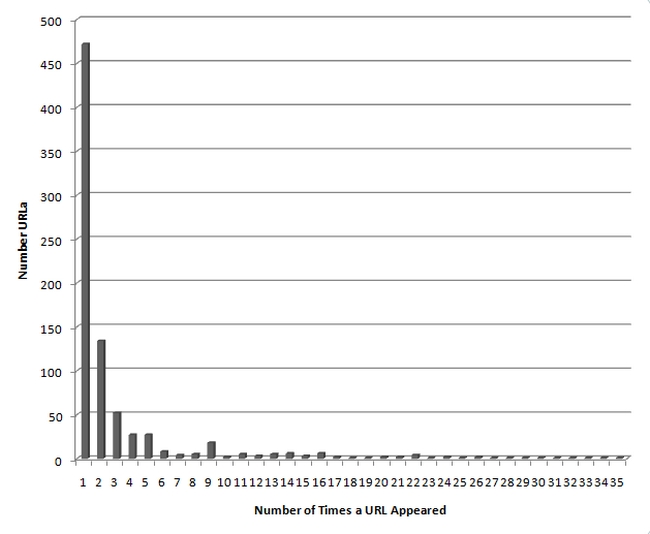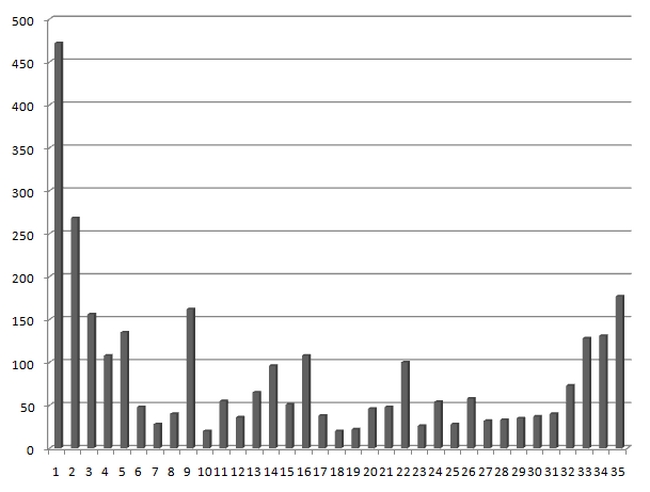
The 'News Move' in Twitter Messaging
Every language community develops conventional phrases, constructions to facilitate communication. Twitter users are no different. They have invented a number of procedures that are important facilitators of their communication. The structure I will analyze here could be called the 'news move.' The form of the messages is: did you see that . . . http://shortened url.
Because Twitter messages are limited to 140 characters a standard url would take most or all of the space available for the message. A number of firms offer to shorten urls going into Twitter messages. After 5 years of watching others shorten urls Twitter has finally bulit that into their processing of messages. That is the reason for "shortened url."
The communication is almost always about something that we would think of as news. I am going to look at the use of urls in Twitter messages mentioning four Republican candidates for the nomination of their party -- Bachmann, Huntsman, Romney, and Ron Paul -- for just over 6 weeks beginning July 7, 2011. Why these four? At the time Romney was the leading candidate. Bachman had just begun to emerge as a favorite with some Republicans. Huntsman was a little known candidate. And Ron Paul is the bane of the mainstream media; he is a candidate who cannot win and should be ignored, but he keeps being popular with a significant number of Republicans. These are examples of this format.
RT @ClaytonMorris: A new poll shows few Republicans care what Palin plans to do. Have they already turned their attention elsewhere? http://t.co/21Y34FL
Huntsman Slams Palin's Tax Proposal: Jon Huntsman, trailing badly in the GOP presidential race, hit hardest Sund... http://t.co/lFnW0ug
Romney Endorsed by SC Treasurer with Strong Tea Party Ties: The Romney campaign will announce this morning that ... http://t.co/vlvu9PL
RT @AnonyOps: Ron Paul reads #wikileaks cable on the house floor, and shows the US government flip-flopped on Saddam. http://t.co/imPq48y #wlfind
News: distribution in a new poll, what Huntsman had to say about a tax proposal, Romney was endorsed, and Ron Paul read a wikileaks cable on the House floor. This is spreading the news.
While it is news, as a form of messaging it is more than only news. The url plays two roles in the communication. First, the original source is recommended to the reader. Second, the reference to the original is justification for what the person is claiming. So, as a figure of speech the 'news move" is informing, recommending, and justifying.
Shortened urls are used much more frequently in Twitter messages about politics than is the case for general Twitter messaging. For the most recent 9,000 messages, as of September 6, mentioning each candidate the numbers are:
| Bachmann | 62.9% |
| Huntsman | 71.4% |
| Romney | 68.4% |
| Ron Paul | 70.6% |
A study conducted by staff of Microsoft based on a sample of all Twitter messages found that 22% contained a url (Boyd et al, 2010). Sixty-three to 71 percent is substantially greater than standard. News is important in political communication, which is surely not surprising.
A standard interpretation of this form of messaging is that the writers are simply repeating news found in the mainstream media. The messaging may spread the news, but it contributes nothing more than is there according to this interpretation. In part this interpretation gains plausibility because of the difficulty in determining what source is being recommended and used to justify the claim. They are shortened urls, as in the examples above, and the only easy way to determine the original source is to click on the url. It is not easy, however, if you have to do it thousands of times.
The research I conducted on breaking news stories of The Washington Post and the amount of Twitter messaging about the same subject pretty clearly indicated that the story is not as simple as one might glean from this interpretation. (Boynton, 2010) The streams of Twitter messages I collected about stories that were not breaking news in the Post were more likely to be in the upper quintiles of the distribution than were the streams about breaking news stories. I am not claiming that all streams of Twitter messages that are about not-breaking news are greater than those that are related to breaking news stories. I am claiming that the assertion that these messages are simply spreading the news of the mainstream media is open to question, that there is more going on there than that interpretation would lead one to believe.
The earlier research is a rather indirect way to assess the interpretation that the Twitter messages containing a url are simply reflecting the news in the mainstream media. A more direct way to assess the interpretation is to examine the sources that are 'buried' in the shortened urls. Converting shortened urls back into the original url is not easy. There are many shorteners. It is not clear how some of them do the shortening. Tweettronics is a firm that searches the Twitter database for messages on subjects of interest to their customers and does advanced analytics with those messages (Tweettronics). One of the analyses they provide is converting shortened urls into the original source url so the origination of the message can be known. But they are only able to find the original url in some cases. The percentage they could recover in each case was: Bachmann 64.1%, Huntsman 40.7%, Romney 60.8%,and Ron Paul 61.5%. With the exception of the Twitter messages mentioning Huntsman Tweettronics was able to identify just over sixty percent of the original urls.
|
"Mainstream media" is an inexact phrase. The above is the list of media organizations that I counted as mainstream. I took only media with a national audience. I did not count local newspapers nor local TV stations. I did not count blogs like the Huffington Post or Hot Air or blogs of individuals. This is a very restrictive specification of mainstream, but I think having a national audience and a long history is implicit in most claims about Twitter messages repeating the news in mainstream media. Note that the counts are for domain names. It is the total of posts from ABC News or from CBS News or from The Washington Post. It is not a count of individual urls; it is a count of the domain or source of the url.
What proportion of the uncovered urls can be traced to these institutions?
Bachmann |
Huntsman |
Romney |
Ron Paul |
10.1% |
11.7% |
10.9 |
3.4% |
Ten percent is it -- except for Ron Paul. The result for Ron Paul is consistent with almost all discussion of the mainstream media. They systematically ignore him in favor of almost any other candidate.
The overall distribution is as important as those numbers. The four distributions are very similar. This is the distribution for Twitter messages mentioning Michele Bachmann.
 |
Four hundred and seventy-two domains appeared in only one of the Twitter messages. The drop is very steep. One hundred and thirty-four appeared in two messages. Fifty-two apeared in three messages. Twenty-seven appeared in four and again in five messages. The figure only goes through 35, but there was one url that appeared in 40 messages, one that appeared in 73 messages, one that appeared in 128 messages, one that appeared in 131 messages, and one that appeared in 177 messages. A very small number of domains appear frequently, but most appear only once or a few times.
If there are a few urls that appear frequently and the rest appear only a few times what are the top domains? This table gives the top ten in number of messages in which they appear for the four candidates. In this table I have not reduced the urls to their domain. For example, google.com and feedproxy.google.com appear in the table. With the exception of Google most entries are unique to a domain.
Bachmann |
Huntsman |
Romney |
Ron Paul |
||||||||||||||||||||||||||||||||||||||||||||||||||||||||||||||||||||||||||||||||
|
|
|
|
There are two first points. One, google dominates the frequently appearing urls. It is first for three of the four candidates, and appears in at least two forms for each candidate. Two, youtube appears far more frequently than might be expected. It is very prominent in messages mentioning Ron Paul, but it also appears in the Bachmann and Romney top ten. The number of times the Huffington Post appears in these urls exceeds the number of times any of the mainstream media appear. The mainstream media are not very prominent among the top ten sources of urls.
However, the interpretation of the dominance of Google is difficult. Google aggregates. We do not know what Google is aggregating. Many of the sources aggregated by Google are undoubtedly mainstream media. One possibility is to assume that they are all mainstream media, which is unlikely. Even if that assumption was true it is still the case that the long tail dominates.
 |
The domain name Google, at 35 on the x axis, is in 171 twitter messages. Even if you assume they are all mainstream media they are substantially fewer references to the the mainstream than the 471 that are not mainstream and that appeared only once. The totals for the long tail exceed the the totals for the domains that appear frequently by a wide margin.
Conclusion
This analysis is a cautionary note.
I chose to work with Twitter messages about candidates because I believe they are more likely to be in the mainsteam media news than other subjects I could have chosen. I was only able to access 60% of the urls to determine their domain. The ones I examined were mostly not mainstream. I assume the other 40% are similar, but I do not know that.
But the rather glib claim that most Twitter messages are simply passing along news from the mainstream media has not been backed up by taking apart the shortened urls in a systematic fashion.
How is this important? The circulation of ideas -- suddenly we have access to the communication behavior of an important group in the circulation of news/ideas in society. As social scientists interested in communication we need systematic research on the movement of ideas: what goes, what does not, where it goes first, how it ends up.. It is surely the case that the mainstream media play an important role in the movement of news. But we have known for a long time that opinion leaders are equally important. We have not been able to follow the communication behavior of opinion leaders. Now we can. We should do it as systematically as possible.
References
Danah Boyd, Scott Golder, Gilad Lotan, "Tweet, Tweet, Retweet: Conversational Aspects of Retweeting on Twitter," hicss, pp.1-10, 2010 43rd Hawaii International Conference on System Sciences, 2010
Boynton, G. R. (2010) Opinion Leadership: Outside the Beltway
Tweettronics at http://www.tweettronics.com They do a search at regular intervals for terms that a user supplies. In addition, they do a number of useful analyses on collected messages. The one that was valuable for this paper was providing full urls for the shortened versions in the Twitter messages.
© G. R. Boynton, 2011